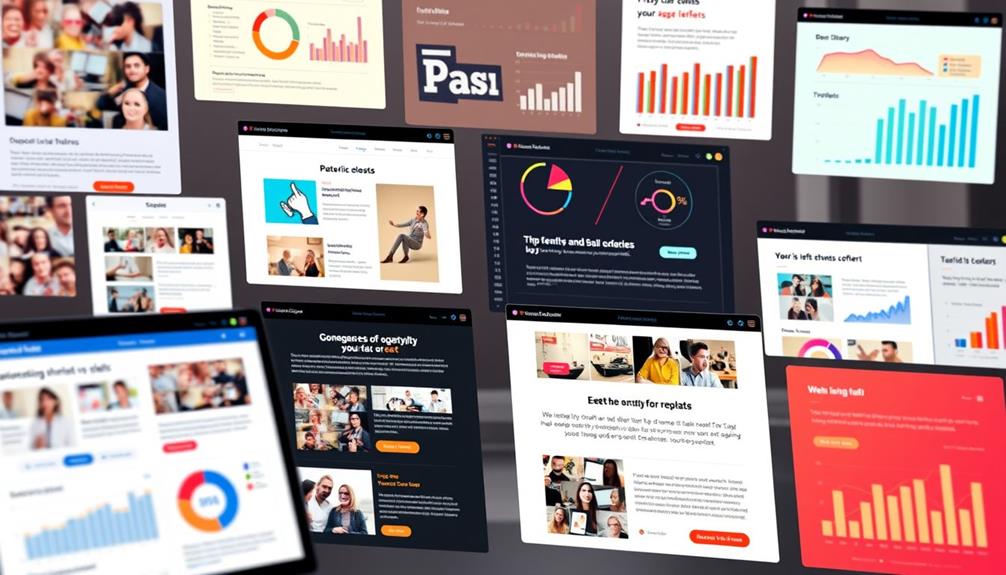Email marketing, a powerful and widely used advertising tool, remains a key player in today’s marketing industry.
From the intricacies of crafting compelling subject lines to the meticulous segmentation of subscriber lists, the nuances of email marketing are both intriguing and impactful.
But how exactly does this method of marketing work, and what makes it so effective in the digital age?
Let's unravel the mechanics behind email marketing, exploring its potential to captivate audiences and drive business growth in today's competitive landscape.
Key Takeaways
- Email marketing allows businesses to connect with their audience through targeted and personalized messages.
- Building a healthy and segmented email list is crucial for successful email marketing campaigns.
- Segmenting the audience based on behavior, interests, or demographics allows for more relevant and engaging email campaigns.
- Personalizing content and automating emails increases engagement, conversions, and customer retention.
Email Marketing Overview
Email marketing is an essential aspect of modern digital marketing strategies. It allows businesses to connect with their audience through targeted and personalized messages. It encompasses various elements such as email marketing campaigns, email marketing strategy, email marketing platform, email service providers, email marketing software, marketing automation, building an email list, and email deliverability.
Understanding how email marketing works involves realizing the importance of a healthy subscriber list over a large one. Emphasizing quality over quantity is crucial. Segmentation of email lists is also important as it allows for targeted messages, driving the success of calls to action in email campaigns.
Targeted emails have proven to be more effective in terms of open rates and engagement compared to other marketing channels such as social media ads. Furthermore, referrals made through email marketing are highly valuable.
Monitoring email metrics such as open rates, click-to-open rates, and sharing of emails provides insights into the success of email marketing campaigns. This helps businesses refine their strategies for better results.
Building Email Lists

How can businesses effectively encourage opt-ins and build a healthy subscriber list for email marketing?
Building an email list requires strategic use of lead magnets and incentives to entice potential subscribers. By offering valuable resources such as e-books, webinars, or exclusive discounts, businesses can make opting in an enticing proposition.
Once subscribers are onboard, it's crucial to segment the email list to send tailored messages that resonate with specific demographics or behaviors. This targeted approach not only helps in driving the success of your call to action but also increases the likelihood of your emails being opened.
Referrals made through email are highly valuable, making a well-crafted email list a powerful asset for any marketing campaign. It's important to be aware of national and international email regulations to ensure compliance while managing and growing your email list.
Engaging in meaningful conversations with your customers through email is also essential for the success of your email marketing efforts.
Segmentation and Targeting
Segmentation and targeting are essential aspects of successful email marketing. By dividing our audience into specific segments based on their behavior, interests, or demographics, we can create targeted email campaigns that are more relevant and engaging.
This allows us to personalize content and deliver messages that resonate with each segment, ultimately leading to higher open rates and conversions.
Customer Segmentation Importance
Understanding the importance of customer segmentation in email marketing is essential for crafting targeted and engaging messages that resonate with specific groups of recipients.
Customer segmentation allows us to segment our email list based on specific types of customer behavior and interests, enabling us to build a relationship with our audience.
By segmenting the list, we can ensure that the right message reaches the right audience, leading to higher open and click-through rates.
This targeted approach also allows for direct communication with subscribers, driving traffic and enabling effective lead nurturing.
Targeted Email Campaigns
To maximize the impact of our email marketing efforts, targeted email campaigns involve tailoring messages to specific groups of subscribers based on their interests or behavior. By sending personalized and relevant content to distinct segments of our email list, we aim to increase engagement and conversion rates. Segmentation allows us to send more targeted call-to-action messages, improving the likelihood of recipients opening and engaging with the email content. This personalized approach leads to better relationships and increased sales. To illustrate, consider the following table:
| Benefits of Targeted Email Campaigns |
|---|
| Higher email open rates |
| Improved engagement |
| Increased conversion rates |
Implementing targeted email campaigns is a crucial aspect of our digital marketing strategy. We use email automation to streamline the process and ensure that our email marketing campaigns are effective and efficient.
Personalized Content Creation
As marketers, we consistently tailor our email content to specific subscriber groups, ensuring that our messages resonate with their interests and behaviors. This personalized content creation involves segmenting our email lists to target recipients with customized messages, focusing on specific products or services that match their preferences.
By dividing our subscribers into smaller, more targeted email targets, we can create more engaging and relevant marketing emails. Additionally, incorporating personalized preview text can further enhance the appeal of our emails to the recipients. This approach has proven to drive the success of the call to action, increasing engagement and conversions.
Ultimately, successful email marketing relies on delivering the right types of emails to the right audience, and personalized content creation is a key strategy in achieving this goal. Personalization in email marketing involves tailoring your content to meet the specific needs and preferences of your target audience. This can include using the recipient’s name, segmenting your mailing list to send targeted emails, and providing relevant and timely information. By incorporating personalization in email marketing, you can increase engagement, drive conversions, and build stronger relationships with your audience.
Email Automation

When implementing email automation, it's essential to understand how to schedule targeted emails to specific segments of your subscriber list. This allows for the delivery of personalized content tailored to the interests and behaviors of different groups within your audience. By sending a series of emails at the right time, to the right email addresses, email automation can significantly increase engagement and drive a higher percentage of recipients to take the desired action.
Furthermore, by automating repetitive tasks, email automation saves time and effort, enabling you to focus on strategic planning and optimization to maximize the return on investment for your email marketing efforts.
Automated emails can be triggered by various actions or behaviors, such as a new subscriber signing up for your newsletter or a customer abandoning their online shopping cart. This level of direct marketing allows for timely and relevant communication with your audience, nurturing leads, building relationships, and increasing customer retention.
Campaign Testing and Optimization

After implementing email automation to deliver personalized content, the next step is to focus on campaign testing and optimization to enhance the performance of your email marketing efforts.
Campaign testing and optimization are crucial for achieving the best results in email marketing. Here's how to do it effectively:
- A/B Testing: Use A/B testing to compare different elements of your email campaigns, such as subject lines, calls to action, and content variations. This helps in identifying the most effective approaches to engage your audience.
- Optimizing Email Delivery: Experiment with different delivery times and days to determine the best time to send your emails. Analyzing customer behavior and response to different email variations is also essential for refining future campaigns.
- Refining Content and Design: Constantly refine the content, layout, and design of your email templates to improve engagement. This includes ensuring compliance with data protection regulations, avoiding spam filters, and delivering impactful promotional messages.
Email Marketing Types and Examples

Let's explore the different types of emails and some examples to illustrate each one.
From promotional emails that highlight special offers to informational newsletters that keep subscribers engaged, there are various ways businesses can use email marketing to connect with their audience.
We'll also take a look at retention emails, which are designed to keep customers engaged and interested in the brand.
Types of Emails
Promotional emails are crafted to showcase special offers, new product releases, and exclusive content to a wide audience, aiming to drive engagement and sales.
Informational emails, such as newsletters, share news related to the business and provide value to the audience.
Transactional emails provide order confirmations, shipping updates, and other important messages to customers.
Retention emails engage customers with the brand, introduce them to the product, and target uninterested contacts to win them back.
- Promotional emails: Highlight special offers and new releases
- Informational emails: Share news and provide value
- Transactional emails: Provide order confirmations and updates
Each email type has its purpose within email marketing, helping businesses to build brand awareness, engage their audience, and drive sales effectively.
Email Marketing Examples
Email marketing examples demonstrate the diverse applications of promotional, informational, and retention emails. These examples showcase how businesses engage their audience and drive sales through targeted and tailored messaging.
One effective strategy is segmenting your email list. This allows you to send relevant content, which is essential for effective email promoting. For instance, a promotional email can help communicate directly with subscribers about sales or new products. On the other hand, an informational email can educate them about industry trends or best practices.
Retention emails are also important in improving the quality of your email marketing. These emails, such as special offers for loyal customers, can help retain customer loyalty and increase repeat purchases.
To ensure that you're using email marketing to its fullest potential for your brand, it's crucial to adjust your strategy based on metrics and feedback. This will help you continuously improve and optimize your email campaigns.
Advantages of Email Marketing

Taking advantage of email marketing provides numerous benefits for businesses looking to engage with their audience and drive meaningful interactions. Email marketing delivers several advantages that can enhance your marketing strategy and help grow your business:
- Targeted Communication: By segmenting your email subscribers, you can tailor your messages to specific demographics, interests, or behaviors, ensuring that your content resonates with your audience and drives meaningful interactions.
- Measurable Results: Email marketing allows you to track open rates, click-through rates, and conversion rates, providing valuable insights into the effectiveness of your campaigns. This data enables you to refine your strategies for improved performance.
- Cost-Effective Customer Acquisition: Acquiring new customers through email marketing is a cost-effective strategy. With compelling content and targeted messaging, you can attract and convert potential leads into loyal customers, ultimately driving revenue growth.
Leveraging the benefits of email marketing not only helps you engage with your existing audience but also provides avenues to attract new customers and achieve your business objectives. By understanding the advantages of email marketing, businesses can maximize the impact of their marketing efforts and foster long-term customer relationships.
Disadvantages of Email Marketing

Despite its potential for targeted communication and measurable results, email marketing also presents several challenges that businesses must navigate to ensure effective engagement with their audience. Marketers say that while email marketing tools offer numerous benefits, there are also drawbacks that need to be addressed. One of the major challenges is the issue of spam emails, which can cause important messages to be overlooked or filtered out. Additionally, the time it takes for large email files to load can lead to loss of interest from potential customers. Competition from other marketers also poses a challenge, requiring strong copywriting or additional promotions to capture recipients' attention. Furthermore, continuous effort is needed to prevent high unopened rates or unsubscribes, demanding ongoing resources and attention. Finally, variations in email design across devices can lead to a less than ideal user experience, impacting the effectiveness of message delivery. To better illustrate these challenges, a table is presented below:
| Challenges | Impact |
|---|---|
| Spam emails | Reduced reach and impact |
| Large file sizes | Slow loading times |
| Competition | Attention capture |
| Continuous engagement | Resources and attention |
| Email design variations | User experience impact |
Is There a Specific Process for Email Marketing?
Mastering email marketing strategies necessitates following a specific process. This involves defining your target audience, creating valuable content, crafting compelling subject lines, and analyzing results to refine your approach. By following these steps, you can effectively reach and engage your audience through email marketing.
Frequently Asked Questions
How Email Marketing Works Step by Step?
We target subscribers with personalized messages, driving higher engagement and conversions. This approach generates high-quality interactions, making email referrals more valuable than those from other channels.
By focusing on a healthy subscriber list and segmenting it for tailored messages, we ensure the success of our call to action.
Compared to social media ads, email recipients are more open to our messages, boosting the effectiveness of our lead generation.
How Email Marketing Is Working?
Email marketing is a powerful tool that works by targeting specific audiences with personalized messages. It drives successful call-to-actions and provides valuable insights through metrics.
To ensure the effectiveness of email marketing, we focus on developing a healthy subscriber list and segmenting it for more effective communication. This helps us tailor our messages to the needs and interests of different groups of subscribers.
Compared to social media ads, targeted emails are more likely to be opened and acted upon. This is because emails are delivered directly to the inbox of the recipient, making them more visible and less likely to be missed.
Additionally, referrals made through email are more valuable. When someone shares a product or service through email, it carries more weight and credibility than a simple social media post.
To measure the effectiveness of our email marketing efforts, we rely on metrics such as open rate and click-to-open rate. These metrics help us gauge how engaging our emails are and how well they are driving conversions.
What Are the 4 Types of Email Marketing?
Sure!
The four types of email marketing are:
- Promotional emails: These emails focus on driving sales and promoting products or services to customers and prospects.
- Transactional emails: These emails provide order confirmations, shipping notifications, and receipts to customers after a purchase. They serve as important transactional communication.
- Relational emails: These emails aim to build long-term customer relationships by providing personalized content and nurturing customer loyalty. They may include welcome emails, birthday emails, or special offers for loyal customers.
- Informational emails: These emails offer valuable content and resources to the audience. They can include newsletters, industry updates, educational materials, and tips or advice related to the company's products or services.
Each type serves a distinct purpose in engaging with customers and prospects.
How Does Email Marketing Service Work?
We use email marketing service to leverage targeted, personalized messages that engage and drive sales. By developing a healthy subscriber list and segmenting it, we tailor messages to drive successful call-to-action outcomes.
Valuable insights from metrics like open rate and CTOR help measure effectiveness. Understanding the value of email marketing leads to better outcomes, building relationships and driving sales.
Service providers' powerful tools, like segmentation and analytics, make impactful email marketing easy.
Conclusion
In conclusion, email marketing is like a fine-tuned orchestra, where every subscriber is a unique instrument playing in harmony. By carefully crafting targeted messages, nurturing subscriber relationships, and analyzing metrics, marketers can create a symphony of success.
Like a well-written novel, email marketing tells a story that captivates and engages the audience, leading to valuable connections and increased sales. It's a powerful tool that continues to evolve and captivate audiences.









